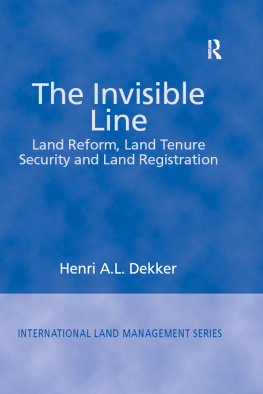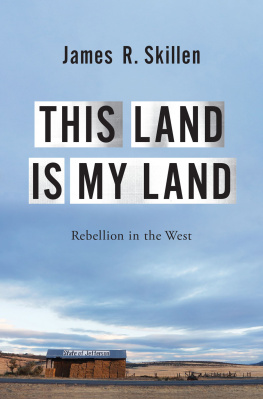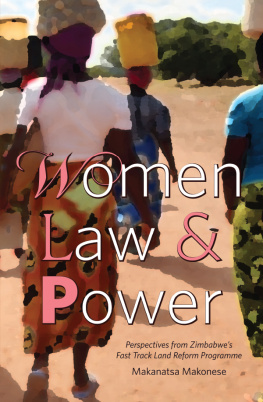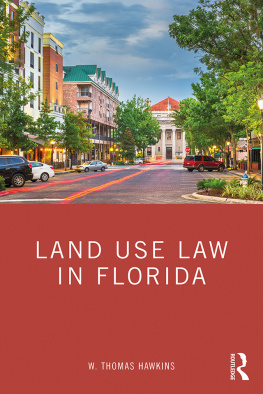First published 2003 by Ashgate Publishing
Published 2016 by Routledge
2 Park Square, Milton Park, Abingdon, Oxon OX14 4RN
711 Third Avenue, New York, NY 10017, USA
Routledge is an imprint of the Taylor & Francis Group, an informa business
Copyright Henri A.L. Dekker 2003
The author has asserted his right under the Copyright, Designs and Patents Act, 1988, to be identified as the author of this work.
All rights reserved. No part of this book may be reprinted or reproduced or utilised in any form or by any electronic, mechanical, or other means, now known or hereafter invented, including photocopying and recording, or in any information storage or retrieval system, without permission in writing from the publishers.
Notice:
Product or corporate names may be trademarks or registered trademarks, and are used only for identification and explanation without intent to infringe.
British Library Cataloguing in Publication Data
Dekker, Henri A. L.
The invisible line : land reform, land tenure security, and land registration. - (International land management series)
1. Land tenure 2. Land tenure - Law and legislation 3. Land
reform
I. Title
333.3
Library of Congress Cataloging-in-Publication Data
Dekker, Henri A. L., 1940-
The invisible line : land reform, land tenure security, and land registration / Henri A.L.Dekker.
p. cm. -- (International land management series)
Includes bibliographical references and index.
ISBN 0-7546-3637-2
1. Land tenure 2. Land reform. 3. Land titles--Registration and transfer. 4. Right of property. I. Title. II. Series.
HD1251.D452003
333.3dc21
2003048920
ISBN 13: 978-0-7546-3637-3 (hbk)
ISBN 13: 978-1-138-25870-9 (pbk)
Have you ever seen the Equator, or the Arctic Circle? Of course you have not; both are invisible lines. You might have been told that you were precisely at the spot on earth where an equator or where an arctic circle was supposed to be. There even might have been a monument or marker to identify the location of the Equator or the Arctic Circle. But you have not actually seen the Equator or Arctic Circle as a line or as a physical phenomenon.
There are many such invisible lines on the globe. Any social organization has established rules, institutions, and customary relationships governing the behavioral relations among individuals and groups, and all these create lines most of which are invisible. Institutions in this book are defined as the humanly devised structures that regulate social interactions. Their invisibility has to do with the fact that social relations do not follow topographic features. However, sometimes they do and then a river, a shoreline, a hedge, a row of trees, a mountain range or a road forms the border between two pieces of property with different property rights. But in most cases the lines caused by a concept initiated in the mind of men remain invisible features. Regularly we want the lines being made visible in the case of disputes over behavior or in the case of uncertainty about rights to land. We want to have certainty to what extent we can establish authority over land. Such actions result in lines to be drawn on the globe, lines to be marked, lines that are precisely described and may appear on maps, and lines that can be indicated and shown on the ground. And although, at such occasions the invisible lines are indicated and marked by topographical features, those physical features do not give any guarantee. Physical features once used to mark the lines are not always reliable. They can shift in position over time by actions of man or natural causes. They can disappear, disintegrate or be taken away. What happens often is that the rights to land change without giving much attention to the markers that once represented the extent of these rights.
It also occurs that fences suffer from wear and tear and are being replaced by newer features, which might be in a slightly different location. A line of small trees replacing an old fence sometimes is planted at one side of the old fence to become the recognized border of a piece of land over time. But then the registered boundary and perhaps the drawn boundary line on a map differs from the new perceived one. So it may happen that people are being misled by physical features or that a mistake is made while determining the location of a physical mark.
Customary land tenure comprises of privileges, duties, and mutual obligations that bind the people of a community to each other and to the land that they regard as their common pool resource. Because the rules are seldom documented, the invisible features of local customs and customary land tenure are even harder to discover. And although invisible, the lines are often deeply rooted in the social relations of local people. These lines generally go unnoticed by outsiders not familiar with the situation in the area. A story of a West African village tells us of project personnel being under the impression that they were legally right and that it was worthless bush that belonged to no one when they bulldozed the community forest for a plantation site. The local villagers returned the favor a few years later by burning the project plantation of exotic flora species to the ground, because that worthless bush had provided the villagers for centuries with wood, animals to hunt, medicinal plants, and fruits. By removing the bush the project personnel had crossed the invisible line(s) of traditional customary rights.
To achieve a certain degree of control over its subjects a central government strives to eliminate local customs. It cannot accept customary rules that vary greatly among the various local communities. The government wants to have insight into its possessions. To do so it needs standardized data on local people that can be compared with data from other local communities and can be put into orderly statistics. But most of the local customs cannot be captured in written documents. And thus it happens that governmental experts, in drawing new legislation, overlook the traditional rights and responsibilities. However, this also may happen intentionally because the customary rules do not easily translate into modern documented legislation. There also is a strong tendency to approach common property as a thing of the past that will eventually become obsolete. Looking to the nations future common property is regarded as not much more than institutional debris, social arrangements that may occur occasionally as an exception outside formal modern legislation.
In customary tenure, we do not only encounter invisible lines, but also invisible layers and time slots. Many customary land tenure regimes carry for the current users of the common land an obligation toward past and future generations. This results in responsibilities toward invisible persons. All these customary obligations establish different rights for several people using the land to harvest plants or their fruits, use trees growing on the land as building materials, and pay tribute to other generations. There are many accounts of cases where customary rules distinguish between ownership of land and trees or crops on the land, or even between specific trees or a specific crop on the land and the rest of the crop or trees. Depending on the use of the land, there also can be sequence in use of the same land, for example, the right to harvest crop for one person and to graze cattle for someone else after the harvest. Some of the land is set aside for religious purposes including paying tributes to past generations. Many of these customary concepts go unnoticed or purposely neglected by experts educated Western style when developing written regulations.







